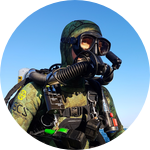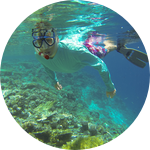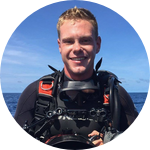About This Project
The Maldivian Manta Ray Project wants to know if manta rays use reef habitats differently when divers/snorkelers are present, as well as deepen our understanding of how temporal scales affect manta activity. Underwater time-lapse cameras will provide new insight into manta behaviour and habitat use, so that we can provide vital scientific guidance to Maldivian communities, businesses and the government; ultimately helping them to protect the local manta population on which their economy depends.
Ask the Scientists
Join The DiscussionWhat is the context of this research?
Threatened by habitat destruction and overfishing, mantas are listed as ‘Vulnerable’ by the IUCN. Ecotourism provides an economic incentive to protect them, but without proper measures it can be harmful to mantas. The Maldives, home to the world’s largest population of reef mantas (Mobula alfredi), makes over US$8 million annually through manta tourism. Tourists regularly dive and snorkel at cleaning stations; areas of reef where small fish ‘clean’ larger animals like mantas. We too frequent these sites to conduct manta surveys and observe interactions. Our research started in 2005 and has played a direct role in gaining national protection for mantas in the Maldives, but ongoing monitoring of these habitats is crucial to assess the effectiveness of these protective measures.
What is the significance of this project?
Scuba diving offers only short glimpses of manta activity each day, greatly limiting our data collection. The deployment of remote underwater cameras will allow us to run uninterrupted, long-term monitoring of cleaning stations for the first time. We will collect comparative data on manta behaviour when divers/snorkelers are present and absent, to assess the impact of tourism practices. We will build a substantial and consistent body of data to demonstrate how the time of day, tidal cycle, lunar phase and monsoon season affect manta presence at cleaning stations. This research is necessary to provide robust, scientific guidance to local communities, tourism operators and the government on maintaining successful, sustainable manta tourism and conserving native marine ecosystems.
What are the goals of the project?
Use underwater time-lapse cameras to continuously monitor one or more cleaning stations in Baa Atoll for the majority of 2018’s manta season (June-November) to:
a) Gather data on manta activity when humans are absent, to aid our research into the effects of scuba divers on manta behaviour.
b) Gain greater insight into the temporal use of cleaning stations by mantas. Learning when stations are being used, how many mantas use each station, how often multiple mantas are cleaning together and how station use changes over a day, lunar cycle, and season.
We will publish a report on our data analysis in spring 2019. The equipment will be utilised beyond the conclusion of this project; monitoring cleaning stations in Baa Atoll and other regions in the Maldives for many years to come.
Budget
Our fundraising target will cover the cost of all accessories needed to deploy two GoPro cameras at a time; four camera set-ups will allow us to continuously monitoring a cleaning station for an entire manta season as we can swap cameras every few days to recharge. Any additional funding above and beyond our target will go towards purchasing additional cameras, allowing us to monitor multiple manta sites.
Accessories include: Underwater housing for our GoPros. External power banks with custom waterproof dive housing that will extend the battery life greatly. Cam-Do Blink Time-lapse controllers that extend the time a GoPro deployment can be used; using these we can programme each GoPro to record only during day light hours and automatically switch off at night.
Endorsed by
 Project Timeline
Project Timeline
We will order all equipment as soon as the funding is released. We anticipate that it will arrive in the Maldives within three weeks of purchase and that it will take a week to prepare it for deployment. So, we hope to have cameras on the reef within a month of receiving funding. We will swap the cameras every few days to recharge, monitoring continuously until the end of manta season. After analysing all data collected 2018’s manta season, we will publish a report on our findings in early 2019.
May 25, 2018
Project Launched
Jun 25, 2018
Project Launch
Jul 25, 2018
Cameras deployed for data collection
Nov 30, 2018
Cameras removed at the end of manta season
Apr 30, 2019
Report published
Meet the Team
Team Bio
The Manta Trust’s goal is a sustainable future for the oceans, where manta rays and their relatives thrive in healthy, diverse marine ecosystems. The Maldivian Manta Ray Project was founded by Dr. Guy Stevens and is the Manta Trust’s flagship project. First established in 2005, it has been researching manta rays in the Maldives for over a decade and has evolved into one of the largest and longest-standing manta conservation groups in the world.
Simon Hilbourne
Having started off as a dive instructor during my gap year, my interest and passion move towards the marine animals I was diving with. After completing my MSci degree in marine biology at the University of Southampton, I worked on whale shark research in Mexico and the Philippines. Currently, I am Research and Administration Officer for the Maldivian Manta Ray Project. I have been working in the Maldives with mantas for nearly two years now and have a strong passion for marine conservation and protecting sharks and rays.
Part of my role here is to find new ways we can study the manta rays and answer many of the unknowns surrounding these beautiful animals. Whenever I go out on our research boat and dive or snorkel with manta rays, I am always fascinated and captivated by them. They are one of the largest fish in the oceans, and yet we know so little about them. When I see them leaving the cleaning stations to swim out into the blue, I’m dying to know where they go, what they do, and why they choose to return to the same cleaning station some time later.
With my role in the Maldivian Manta Ray Project and small projects such as this one, I hope to help answer some of those questions for myself and the scientific community as a whole.
Project Backers
- 66Backers
- 102%Funded
- $5,485Total Donations
- $83.11Average Donation


